From Problems to Possibilities: Overcoming Commercialization Challenges to Scale Timber Bamboo in Buildings
Abstract
1. Introduction
2. Review: Trends in Timber Bamboo Research
2.1. Comparative Analysis of Bamboo with Traditional Building Materials
2.2. Comparative Analysis of Bamboo with Other Biogenic Building Materials
2.3. Bibliometric Network Analysis Using VOSviewer
3. The Climate and Load-Bearing Promise of Timber Bamboo
3.1. Comparative Carbon Footprint of Timber Bamboo
3.2. Comparative Mechanical Properties of Timber Bamboo
4. Adoption of Engineered Structural Bamboo Building Products—Problems & Possibilities
4.1. Raw Material Acquisition
4.2. Limited Commercial Plantations
4.3. Harvesting Technology
4.4. Processing and Manufacturing
- Top: 3–5 m in length. This section is best suited for splitting open the bamboo culms, which are then defibrated or shredded to produce scrim and fiber. Due to its fibrous nature and high strength, the top section is ideal for producing scrimber and other fiber-based products.
- Middle: 13–16 m in length. This section can be split open, sawed into strips, or rotary cut. The resulting elements include flattened strips, laminated lamella, or veneer, which are then used to create laminated bamboo lumber (LBL) and veneers. The balanced properties of the middle section make it ideal for high-quality veneers and laminated products used in flooring, paneling, and furniture.
- Bottom: 5–7 m in length. This section is processed by sawing into strips or rotary cutting. The elements produced include densified strips or lamella, which are used to create structural components and densified strips for construction applications. The bottom section, being the densest and strongest, is best suited for structural components.
4.5. Sub-Optimal Market Application
5. Potential Carbon Impact
6. Conclusions
Author Contributions
Funding
Institutional Review Board Statement
Informed Consent Statement
Data Availability Statement
Conflicts of Interest
Correction Statement
References
- Chaowana, P. Bamboo: An alternative raw material for wood and wood-based composites. J. Mater. Sci. Res. 2013, 2, 90. [Google Scholar] [CrossRef]
- Prajapati, G.; Dua, S. A Critical Review of Bamboo as a Building Material for Sustainable Development. J. Sustain. Constr. Eng. Proj. Manag. 2022, 4, 1–8. [Google Scholar]
- Kartono, B.; Nik Ahmad Ariff, N.S.; Purnomo, A.; Ezran, M. Bamboo material for sustainable development: A systematic review. E3S Web Conf. 2023, 444, 01011. [Google Scholar] [CrossRef]
- Sil, A. Bamboo—A green construction material for housing towards sustainable economic growth. Int. J. Civ. Eng. Technol. 2022, 13, 1–9. [Google Scholar] [CrossRef]
- Manandhar, R.; Kim, J.-H.; Kim, J.-T. Environmental, social and economic sustainability of bamboo and bamboo-based construction materials in buildings. J. Asian Archit. Build. Eng. 2019, 18, 49–59. [Google Scholar] [CrossRef]
- Goh, Y.; Yap, S.P.; Tong, T. Bamboo: The emerging renewable material for sustainable construction. In Reference Module in Materials Science and Materials Engineering; Elsevier: Amsterdam, The Netherlands, 2019. [Google Scholar] [CrossRef]
- Adier, M.F.V.; Sevilla, M.E.P.; Valerio, D.N.R.; Ongpeng, J.M.C. Bamboo as Sustainable Building Materials: A Systematic Review of Properties, Treatment Methods, and Standards. Buildings 2023, 13, 2449. [Google Scholar] [CrossRef]
- Bundi, T.; Lopez, L.F.; Habert, G.; Zea Escamilla, E. Bridging housing and climate needs: Bamboo construction in the Philippines. Sustainability 2024, 16, 498. [Google Scholar] [CrossRef]
- Panti, C.A.T.; Cañete, C.S.; Navarra, A.R.; Rubinas, K.D.; Garciano, L.E.O.; López, L.F. Establishing the characteristic compressive strength parallel to fiber of four local Philippine bamboo species. Sustainability 2024, 16, 3845. [Google Scholar] [CrossRef]
- Levina, A.G.; Utomo, M.M.B. Performance and development challenges of micro–small bamboo enterprises in Gunungkidul, Indonesia. Adv. Bamboo Sci. 2023, 4, 100037. [Google Scholar] [CrossRef]
- Li, W.; He, S. Research on the utilization and development of bamboo resources through problem analysis and assessment. IOP Conf. Ser. Earth Environ. Sci. 2019, 300, 052028. [Google Scholar] [CrossRef]
- Wang, G.; Zhang, W.; Diao, X.; Ji, M.; Fei, B.; Miao, H. Analysis of Harvesting Methods of Moso Bamboo. Buildings 2023, 13, 365. [Google Scholar] [CrossRef]
- Guerra, S.P.S.; Oguri, G.; Eufrade, H.J.; Melo, R.X.; Spinelli, R. Mechanized harvesting of bamboo plantations for energy production: Preliminary tests with a cut-and-shred harvester. Energy Sustain. Dev. 2016, 34, 62–66. [Google Scholar] [CrossRef]
- Madhushan, S.; Buddika, S.; Bandara, S.; Navaratnam, S.; Abeysuriya, N. Uses of Bamboo for Sustainable Construction—A Structural and Durability Perspective—A Review. Sustainability 2023, 15, 11137. [Google Scholar] [CrossRef]
- United Nations Environment Programme; Yale Center for Ecosystems + Architecture. Building Materials and the Climate: Constructing a New Future; United Nations Environment Programme: Nairobi, Kenya, 2023; Available online: https://wedocs.unep.org/20.500.11822/43293 (accessed on 17 July 2024).
- McKinsey Company. Reducing Embodied Carbon in New Construction; McKinsey & Company: New York, NY, USA, 2022; Available online: https://www.mckinsey.com/industries/travel-logistics-and-infrastructure/how-we-help-clients/global-infrastructure-initiative/voices/reducing-embodied-carbon-in-new-construction (accessed on 27 December 2024).
- Bitting, S.; Derme, T.; Lee, J.; Van Mele, T.; Dillenburger, B.; Block, P. Challenges and Opportunities in Scaling up Architectural Applications of Mycelium-Based Materials with Digital Fabrication. Biomimetics 2022, 7, 44. [Google Scholar] [CrossRef] [PubMed] [PubMed Central]
- Dessi-Olive, J. Strategies for Growing Large-Scale Mycelium Structures. Biomimetics 2022, 7, 129. [Google Scholar] [CrossRef] [PubMed] [PubMed Central]
- Yadav, M.; Saini, A. Opportunities & challenges of hempcrete as a building material for construction: An overview. Mater. Today Proc. 2022, 65, 2021–2028. [Google Scholar] [CrossRef]
- Di Sarno, L.; Albuhairi, D.; Peres Medeiros, J.M. Exploring innovative resilient and sustainable bio-materials for structural applications: Hemp-fibre concrete. Structures 2024, 68, 107096. [Google Scholar] [CrossRef]
- Lecompte, T.; Le Duigou, A. Mechanics of straw bales for building applications. J. Build. Eng. 2017, 9, 84–90. [Google Scholar] [CrossRef]
- The Business Research Company. Construction Global Market Opportunities and Strategies to 2032; The Business Research Company: London, UK, 2023. [Google Scholar]
- Kumar, V.; Lo Ricco, M.; Bergman, R.D.; Nepal, P.; Poudyal, N.C. Environmental impact assessment of mass timber, structural steel, and reinforced concrete buildings based on the 2021 international building code provisions. Build. Environ. 2024, 251, 111195. [Google Scholar] [CrossRef]
- Younis, A.; Dodoo, A. Cross-laminated timber for building construction: A life-cycle-assessment overview. J. Build. Eng. 2022, 52, 104482. [Google Scholar] [CrossRef]
- Ryberg, M.W.; Ohms, P.K.; Møller, E.; Lading, T. Comparative life cycle assessment of four buildings in Greenland. Build. Environ. 2021, 204, 108130. [Google Scholar] [CrossRef]
- Hinkle, H.; McGinley, M.; Hargett, T.; Dascher, S. Carbon Farming with Timber Bamboo: A Superior Sequestration System Compared to Wood; BamCore: Ocala, FL, USA, 2019; Available online: https://www.bamcore.com/_files/ugd/77318d_568cbad9ac2e443e87d69011ce5f48b2.pdf?index=true (accessed on 27 December 2024).
- U.S. Department of Commerce, Bureau of Economic Analysis. Fixed Assets and Consumer Durable Goods in the United States, 1925–1999; U.S. Government Printing Office: Washington, DC, USA, 2003.
- Yiping, L.; Yanxia, L.; Buckingham, K.; Henley, G.; Guomo, Z. Bamboo and Climate Change Mitigation; INBAR Technical Report 32; International Network for Bamboo and Rattan (INBAR): Beijing, China, 2010. [Google Scholar]
- Nath, A.J.; Lal, R.; Das, A.K. Managing woody bamboos for carbon farming and carbon trading. Glob. Ecol. Conserv. 2015, 3, 654–663. [Google Scholar] [CrossRef]
- Islam Sohel, M.S.; Alamgir, M.; Akhter, S.; Rahman, M. Carbon storage in a bamboo (Bambusa vulgaris) plantation in the degraded tropical forests: Implications for policy development. Land Use Policy 2015, 49, 142–151. [Google Scholar] [CrossRef]
- Yuen, J.Q.; Fung, T.; Ziegler, A.D. Carbon stocks in bamboo ecosystems worldwide: Estimates and uncertainties. For. Ecol. Manag. 2017, 393, 113–138. [Google Scholar] [CrossRef]
- Kuehl, Y.; Henley, G.; Yiping, L. The Climate Change Challenge and Bamboo: Mitigation and Adaptation; INBAR Working Paper No. 65; Benton, A., Ed.; International Network for Bamboo and Rattan (INBAR): Beijing, China, 2011. [Google Scholar]
- Chilton, K.; Arehart, J.; Hinkle, H. Evaluating Fast-Growing Fibers for Building Decarbonization with Dynamic LCA. Sustainability 2025, 17, 401. [Google Scholar] [CrossRef]
- Kadivar, M.; Gauss, C.; Mármol, G.; de Sá, A.D.; Fioroni, C.; Ghavami, K.; Savastano, H., Jr. The influence of the initial moisture content on densification process of D. asper bamboo: Physical-chemical and bending characterization. Constr. Build. Mater. 2019, 229, 116896. [Google Scholar] [CrossRef]
- Kadivar, M.; Gauss, C.; Stanislas, T.T.; Ahrar, A.J.; Charca, S.; Savastano, H. Effect of bamboo species and pre-treatment method on physical and mechanical properties of bamboo processed by flattening-densification. Mater. Chem. Phys. 2022, 291, 126746. [Google Scholar] [CrossRef]
- Adam, N.; Jusoh, I. Physical and mechanical properties of Dendrocalamus asper and Bambusa vulgaris. Trans. Sci. Technol. 2019, 6, 95–101. [Google Scholar]
- Zakikhani, P.; Zahari, R.; bin Haji Hameed Sultan, M.T.; Majid, D.L.A.A. Morphological, mechanical, and physical properties of four bamboo species. BioResources 2017, 12, 2479. [Google Scholar] [CrossRef]
- Awalluddin, D.; Mohd Ariffin, M.A.; Osman, M.H.; Hussin, M.W.; Ismail, M.A.; Lee, H.-S.; Abdul Shukor Lim, N.H. Mechanical properties of different bamboo species. MATEC Web Conf. 2017, 138, 01024. [Google Scholar] [CrossRef]
- Glória, G.O.; Margem, F.M.; Ribeiro, C.G.D.; de Moraes, Y.M.; da Cruz, R.B.; Silva, F.A.; Monteiro, S.N. Charpy impact tests of epoxy composites reinforced with giant bamboo fibers. Mater. Res. 2015, 18 (Suppl. S2), 178–184. [Google Scholar] [CrossRef]
- Siam, N.A.; Uyup, M.K.A.; Hamdan, H.; Mohmod, A.L.; Awalludin, M.F. Anatomical, physical, and mechanical properties of thirteen malaysian bamboo species. BioResources 2019, 14, 3925–3943. [Google Scholar] [CrossRef]
- Russ, N.M.; Hanid, M.; Ye, K.M. Literature review on green cost premium elements of sustainable building construction. Int. J. Technol. 2018, 9, 1715–1725. [Google Scholar] [CrossRef]
- FAO. Global Forest Resources Assessment 2020: Main Report; FAO: Rome, Italy, 2020. [Google Scholar] [CrossRef]
- WBO. 2024 Global Bamboo Plantation Resource Survey Results Report; WBO: Boston, MA, USA, 2024. [Google Scholar]
- Daniell, J.; Wenzel, F.; Khazai, B.; Vervaeck, A. A country-by-country building inventory and vulnerability index for earthquakes in comparison to historical CATDAT damaging earthquakes database losses. In Proceedings of the Australian Earthquake Engineering Society 2011 Conference, Barossa Valley, Australia, 18–20 November 2011. [Google Scholar]
- Camp, M. North America’s Top Timberland Owners and Managers: 2024 Update. Forisk Consulting. 9 May 2024. Available online: https://forisk.com/blog/2024/05/09/north-americas-top-timberland-owners-and-managers-2024-update/ (accessed on 31 December 2024).
- Travasso, S.M.; Thomas, T.; Makkar, S.; John, A.T.; Webb, P.; Swaminathan, S. Contextual factors influencing production, distribution, and consumption of nutrient-rich foods in Bihar, India: A qualitative study of constraints and facilitators. Food Nutr. Bull. 2023, 44, 100–115. [Google Scholar] [CrossRef]
- Buckingham, K. Rebranding Bamboo: The Bonn 5 Million Hectare Restoration Pledge. World Resources Institute. 23 December 2014. Available online: https://www.wri.org/insights/rebranding-bamboo-bonn-5-million-hectare-restoration-pledge (accessed on 31 December 2024).
- King, C.; van der Lugt, P.; Thang Long, T.; Yanxia, L. Integration of Bamboo Forestry into Carbon Markets; International Bamboo and Rattan Organisation (INBAR): Beijing, China, 2021. [Google Scholar]
- Picchi, G.; Sandak, J.; Grigolato, S.; Panzacchi, P.; Tognetti, R. Smart Harvest Operations and Timber Processing for Improved Forest Management. In Climate-Smart Forestry in Mountain Regions. Managing Forest Ecosystems; Tognetti, R., Smith, M., Panzacchi, P., Eds.; Springer: Cham, Switzerland, 2022; Volume 40. [Google Scholar] [CrossRef]
- Lindroos, O.; La Hera, P.X.; Häggström, C. Drivers of advances in mechanized timber harvesting: A selective review of technological innovation. Croat. J. For. Eng. 2017, 38, 243–258. [Google Scholar]
- Darabant, A.; Rai, P.B.; Staudhammer, C.L.; Dorji, T. Designing and Evaluating Bamboo Harvesting Methods for Local Needs: Integrating Local Ecological Knowledge and Science. Environ. Manag. 2016, 58, 312–322. [Google Scholar] [CrossRef] [PubMed]
- Guan, Y.; Li, S.; Xiong, J.; Xu, B.; Liu, P.; Li, H. Design of bamboo cutting mechanism based on crack propagation principle. BioResources 2021, 16, 5890–5900. [Google Scholar] [CrossRef]
- Wang, X.; Cheng, K.J. Effect of glow-discharge plasma treatment on contact angle and micromorphology of bamboo green surface. Forests 2020, 11, 1293. [Google Scholar] [CrossRef]
- Wu, S.; Liang, L.; Chen, F.; Yang, Z.; Zheng, Y.; Wu, Y.; Li, L.; Lou, G.; Dai, J.; Pang, Y.; et al. Improving the wet adhesive bonding of bamboo urea-formaldehyde adhesive using styrene acrylate by controlling monomer ratios. J. Appl. Polym. Sci. 2022, 139, e53106. [Google Scholar] [CrossRef]
- Scurlock, J.M.O.; Dayton, D.C.; Hames, B.R. Bamboo: An overlooked biomass resource? Biomass Bioenergy 2000, 19, 229–244. [Google Scholar] [CrossRef]
- Xu, W.; Fang, Z.; Fan, S.; Deng, S. Evaluation of the Moso bamboo age determination based on laser echo intensity. Remote Sens. 2022, 14, 2550. [Google Scholar] [CrossRef]
- Habib, A. LiDAR Technology for Scalable Forest Inventory. GIM International. 26 April 2023. Available online: https://www.gim-international.com/content/article/lidar-technology-for-scalable-forest-inventory (accessed on 31 December 2024).
- Yang, Z.; Meng, X.; Zeng, G.; Wei, J.; Wang, C.; Yu, W. Effect of resin content on the structure, water resistance, and mechanical properties of high-density bamboo scrimbers. Polymers 2024, 16, 797. [Google Scholar] [CrossRef]
- Liang, L.; Zheng, Y.; Wu, Y.; Yang, J.; Wang, J.; Tao, Y.; Li, L.; Ma, C.; Pang, Y.; Chen, H.; et al. Surfactant-induced reconfiguration of urea-formaldehyde resins enables improved surface properties and gluability of bamboo. Polymers 2021, 13, 3542. [Google Scholar] [CrossRef] [PubMed]
- Abidin, W.N.S.N.Z.; Al-Edrus, S.S.O.; Hua, L.S.; Ghani, M.A.A.; Bakar, B.F.A.; Ishak, R.; Qayyum Ahmad Faisal, F.; Sabaruddin, F.A.; Kristak, L.; Lubis, M.A.R.; et al. Properties of phenol formaldehyde-bonded layered laminated woven bamboo mat boards made from Gigantochloa scortechinii. Appl. Sci. 2023, 13, 47. [Google Scholar] [CrossRef]
- Zheng, J.; Zhi, Z.; Zhang, E.; Yu, Y.; Wu, Q. Design and evaluation of bamboo-based elastic cushion by human pressure distribution. In Frontiers in Artificial Intelligence and Applications: Design Studies and Intelligence Engineering; IOS Press: Amsterdam, The Netherlands, 2022; Volume 347, pp. 321–328. [Google Scholar] [CrossRef]
- Li, Z.; Chen, C.; Mi, R.; Gan, W.; Dai, J.; Jiao, M.; Xie, H.; Yao, Y.; Xiao, S.; Hu, L. A strong, tough, and scalable structural material from fast-growing bamboo. Adv. Mater. 2020, 32, 1906308. [Google Scholar] [CrossRef] [PubMed]
- ASTM A36/A36M-19; Standard Specification for Carbon Structural Steel. ASTM International: West Conshohocken, PA, USA, 2019.
- World Green Building Council. Bringing Embodied Carbon Upfront. 2019. Available online: https://worldgbc.org/advancing-net-zero/embodied-carbon/?utm_source=chatgpt.com (accessed on 27 December 2024).
- Ritchie, H.; Roser, M. CO2 Emissions. Our World in Data. 2020. Available online: https://ourworldindata.org/co2-emissions (accessed on 27 December 2024).
- Cabeza, L.F.; Boquera, L.; Chàfer, M.; Vérez, D. Embodied energy and embodied carbon of structural building materials: Worldwide progress and barriers through literature map analysis. Energy Build. 2021, 231, 110612. [Google Scholar] [CrossRef]
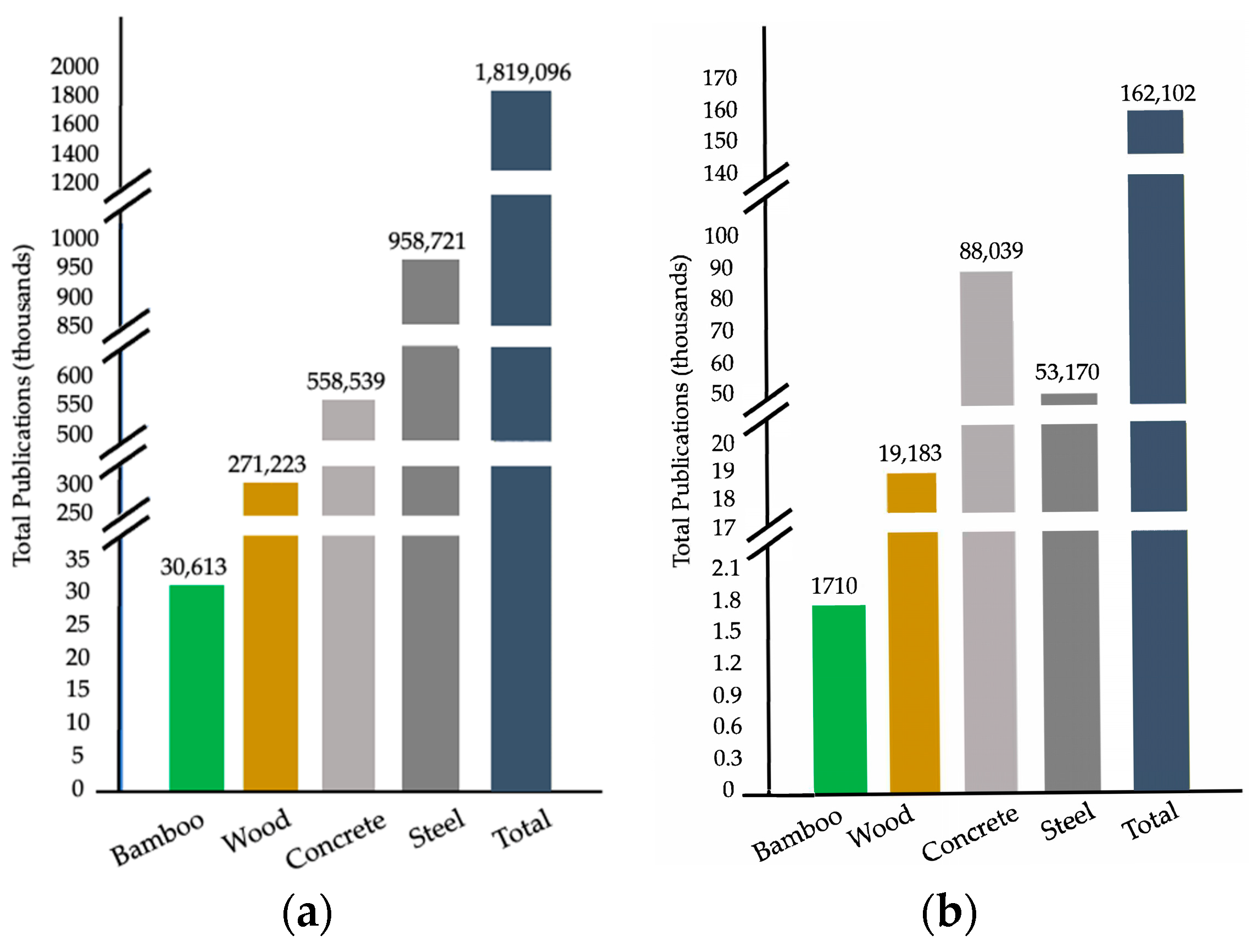

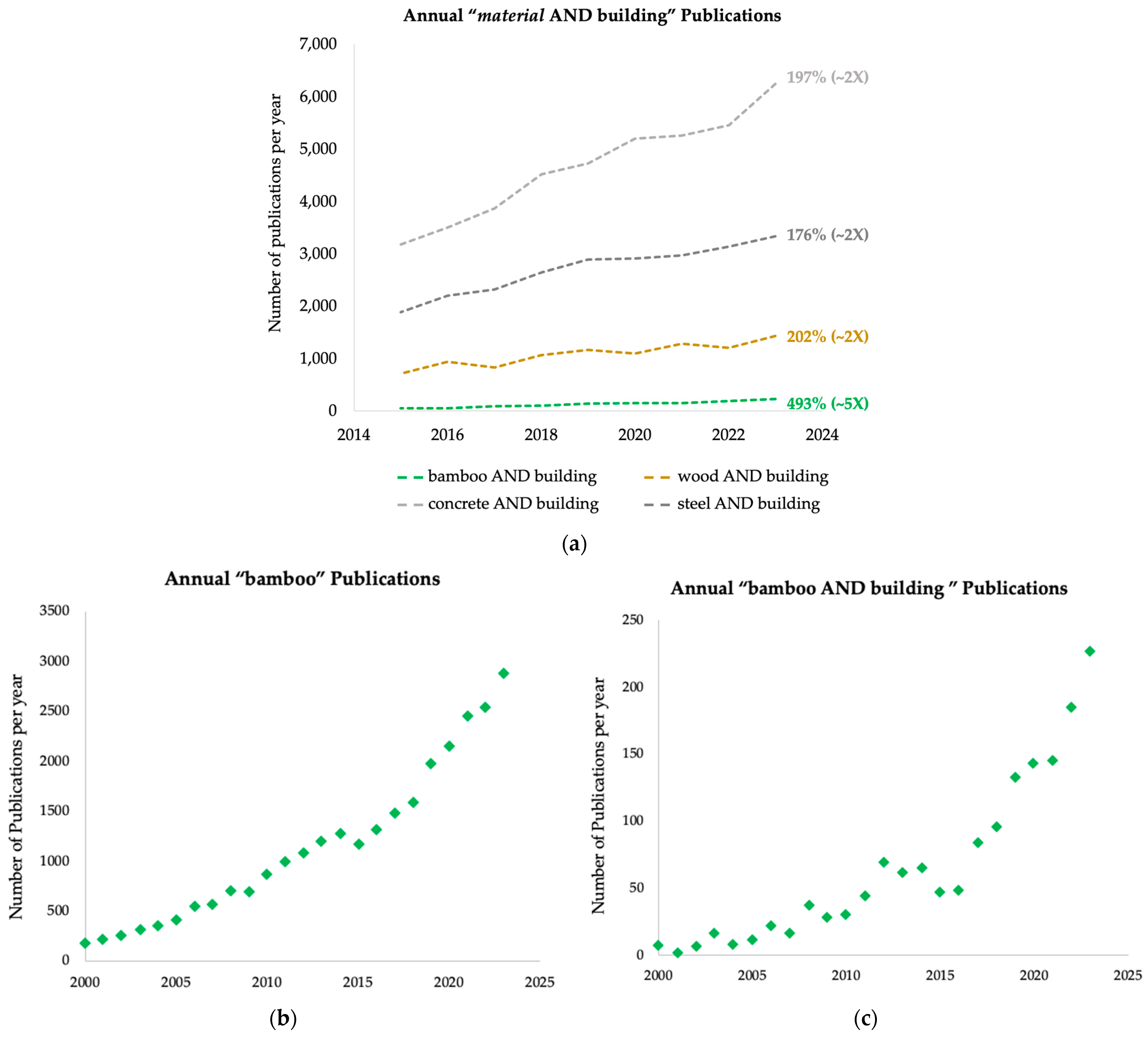


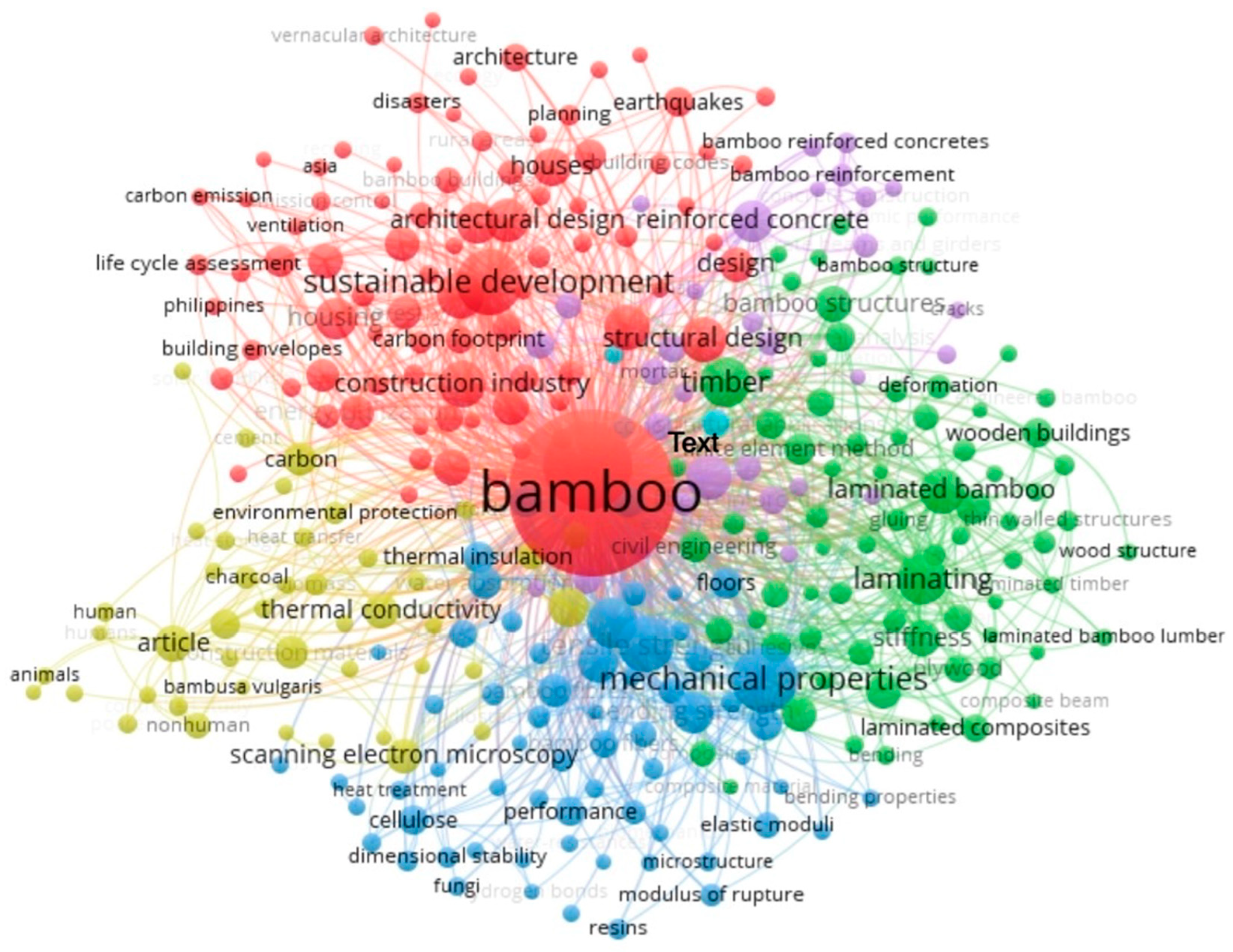

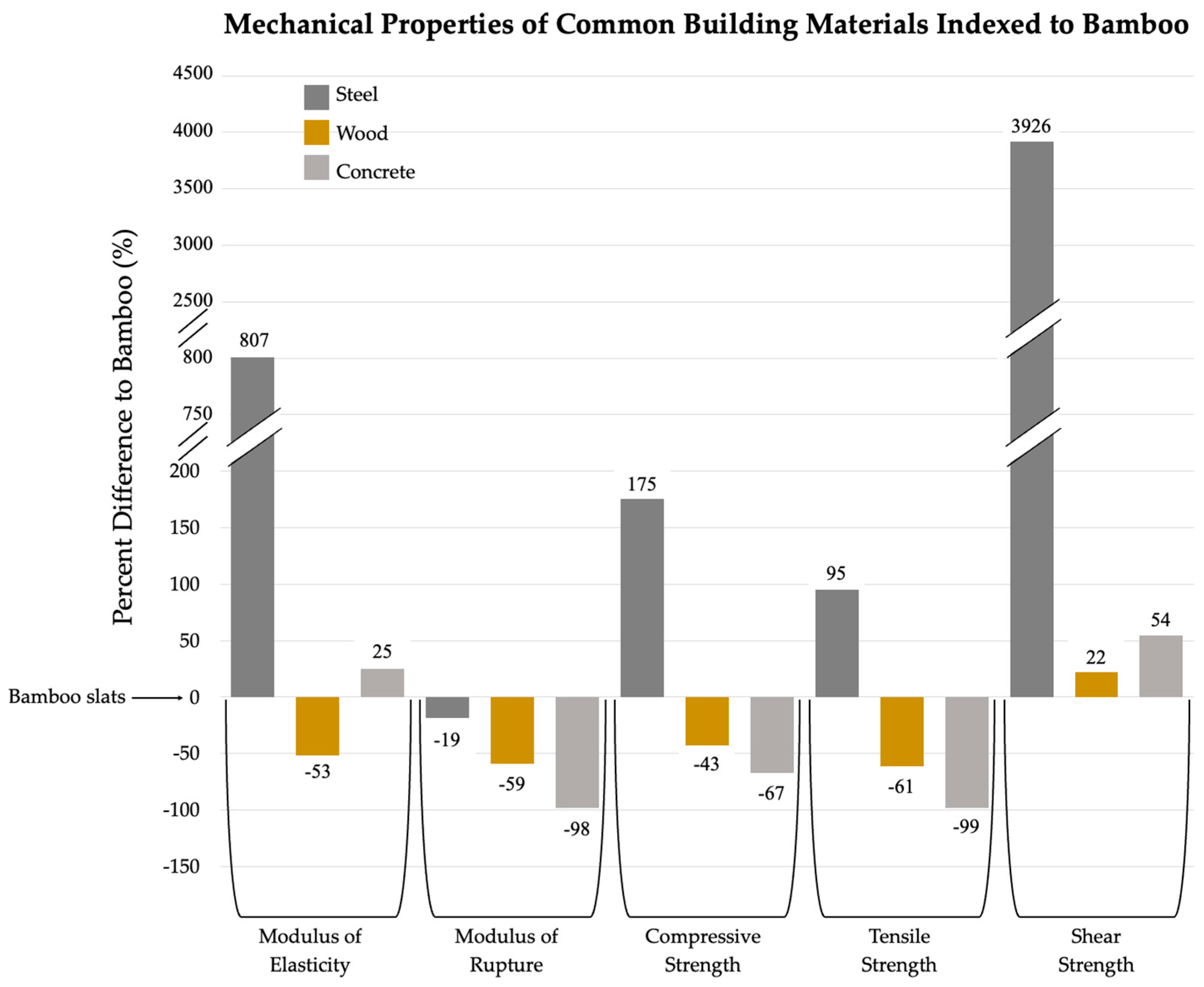


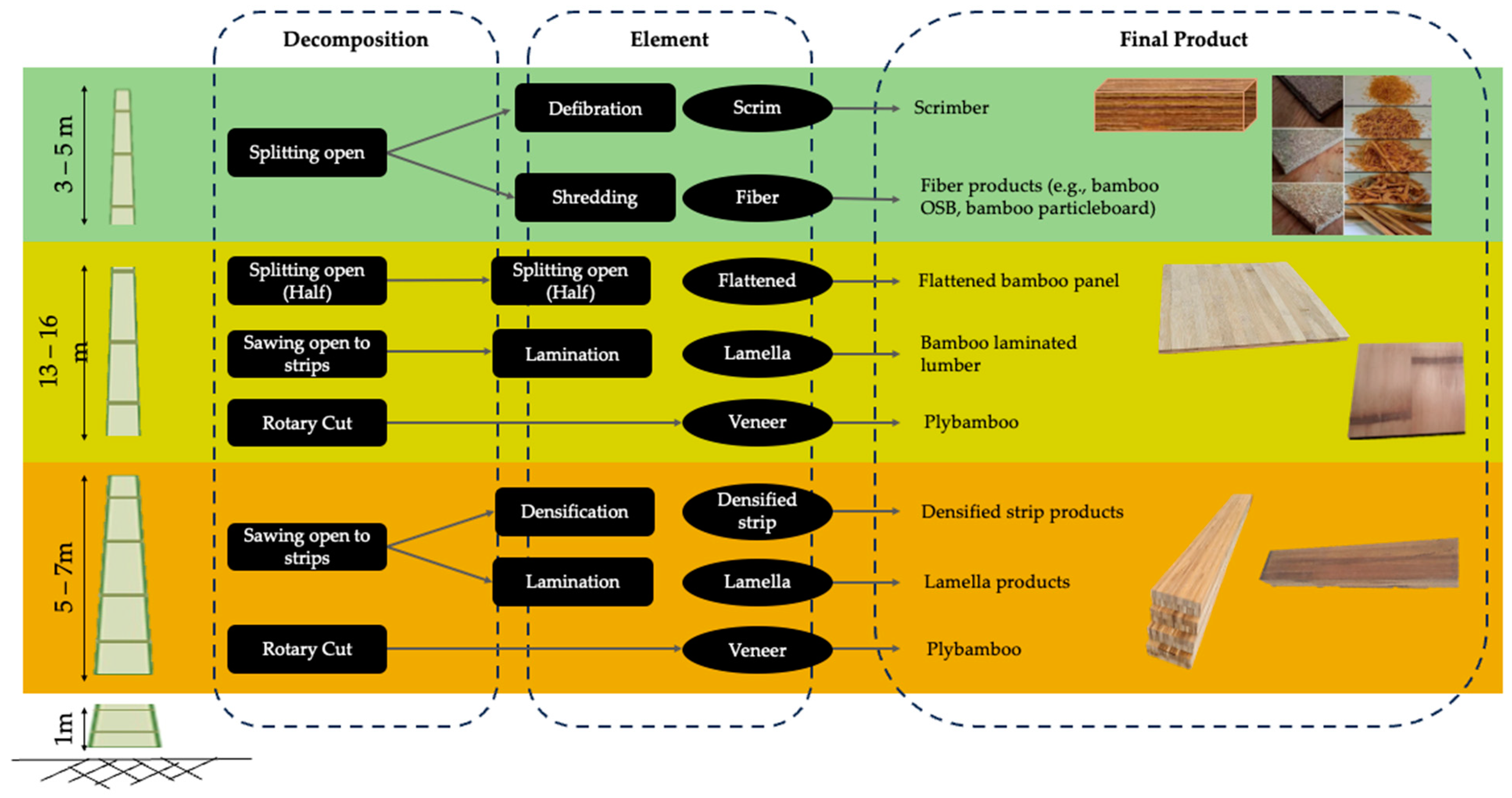
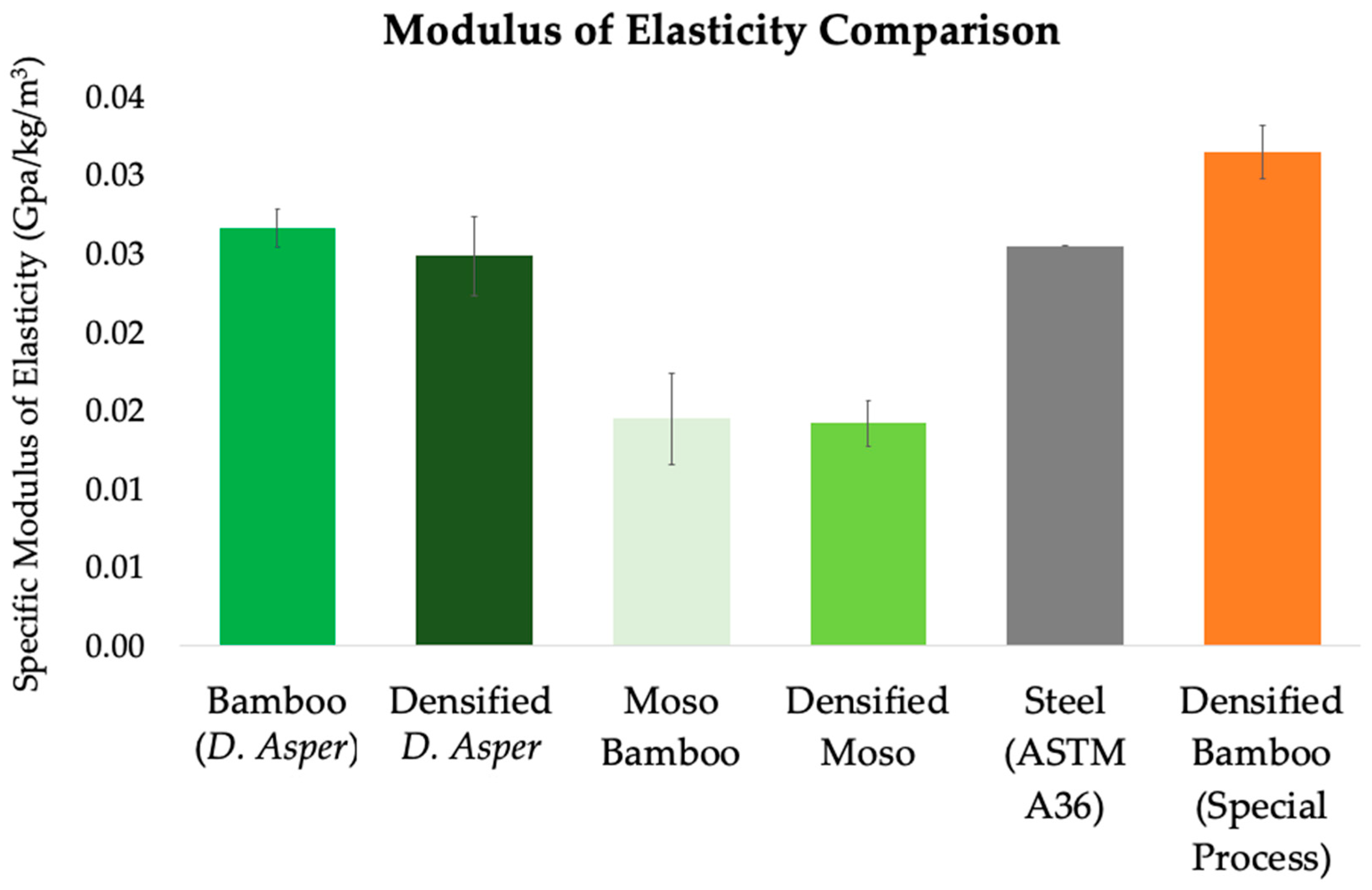
| Factor | Property Affected |
|---|---|
| Variation in number of fibers in the culm wall | Poisson’s ratio, density, creep, and deformation |
| Variation in cross-section along the length of the culm | Density, elastic modulus, shrinkage, creep, deformation, and tensile strength |
| Moisture content | Elastic modulus, compressive strength, bending strength, shear strength, shrinkage, creep, and deformation |
| Age of culm | Shrinkage, creep and deformation |
| Environmental growth conditions | Poisson’s ratio, elastic modulus, compressive strength, and tensile strength |
| Material | Advantages | Disadvantages |
|---|---|---|
| Structural Steel |
|
|
| Reinforced Concrete |
|
|
| Traditional North American Framing Wood |
|
|
| Timber Bamboo |
|
|
| Section | Top | Middle | Bottom |
|---|---|---|---|
| Size | 3–5 m | 13–16 m | 5–7 m |
| Decomposition | Splitting open the bamboo culms | Splitting open, sawing open to strips, or rotary cutting | Sawing open to strips or rotatory cutting |
| Element | Defibration or shredding to produce scrim and fiber | Producing flattened strips, laminated lamella, or veneer | Producing densified strips or lamella |
| Final Product | Scrimber and fiber-based products | Laminated bamboo lumber (LBL) and veneers | Densified bamboo strips and structural elements |
| Suitability | Best for producing scrimber due to its fibrous nature and high strength | Ideal for producing high-quality veneers and laminated products used in floor, panelling, and furniture due to its balanced properties | As the densest and strongest section, best for creating structural components and densified strips for construction applications |
Disclaimer/Publisher’s Note: The statements, opinions and data contained in all publications are solely those of the individual author(s) and contributor(s) and not of MDPI and/or the editor(s). MDPI and/or the editor(s) disclaim responsibility for any injury to people or property resulting from any ideas, methods, instructions or products referred to in the content. |
© 2025 by the authors. Licensee MDPI, Basel, Switzerland. This article is an open access article distributed under the terms and conditions of the Creative Commons Attribution (CC BY) license (https://creativecommons.org/licenses/by/4.0/).
Share and Cite
Chilton, K.; Kadivar, M.; Hinkle, H. From Problems to Possibilities: Overcoming Commercialization Challenges to Scale Timber Bamboo in Buildings. Sustainability 2025, 17, 1575. https://doi.org/10.3390/su17041575
Chilton K, Kadivar M, Hinkle H. From Problems to Possibilities: Overcoming Commercialization Challenges to Scale Timber Bamboo in Buildings. Sustainability. 2025; 17(4):1575. https://doi.org/10.3390/su17041575
Chicago/Turabian StyleChilton, Kate, Marzieh Kadivar, and Hal Hinkle. 2025. "From Problems to Possibilities: Overcoming Commercialization Challenges to Scale Timber Bamboo in Buildings" Sustainability 17, no. 4: 1575. https://doi.org/10.3390/su17041575
APA StyleChilton, K., Kadivar, M., & Hinkle, H. (2025). From Problems to Possibilities: Overcoming Commercialization Challenges to Scale Timber Bamboo in Buildings. Sustainability, 17(4), 1575. https://doi.org/10.3390/su17041575






